Reims, France, July 3rd - 10th, 1910
The biggest aviation meeting before the Great War

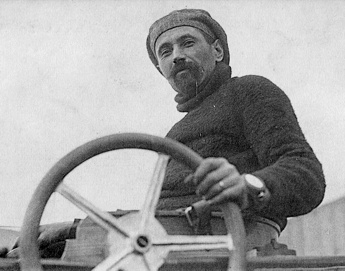
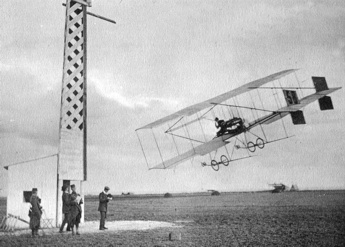
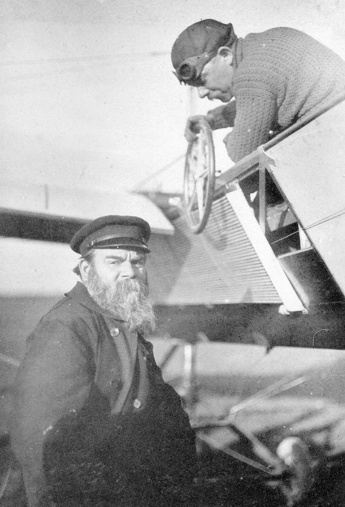
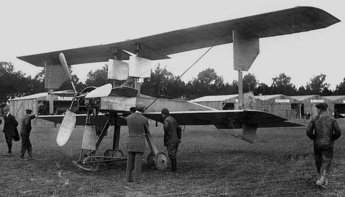
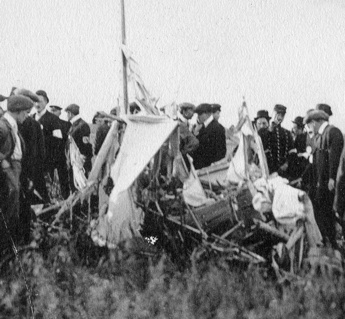
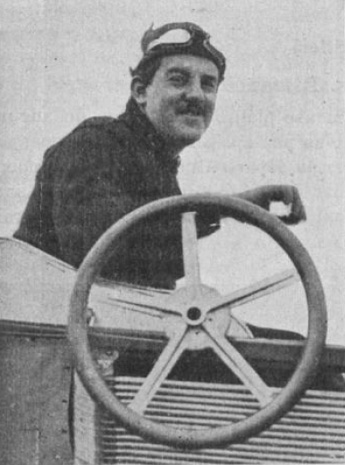
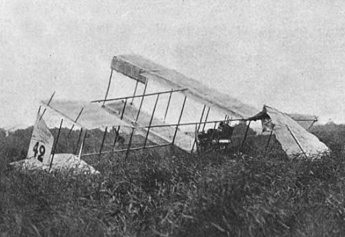
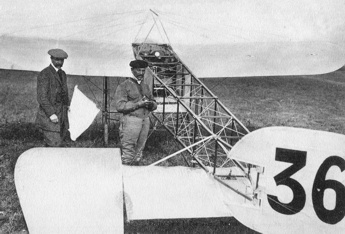
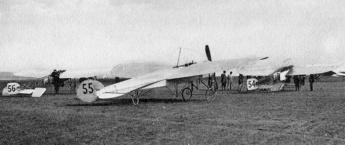
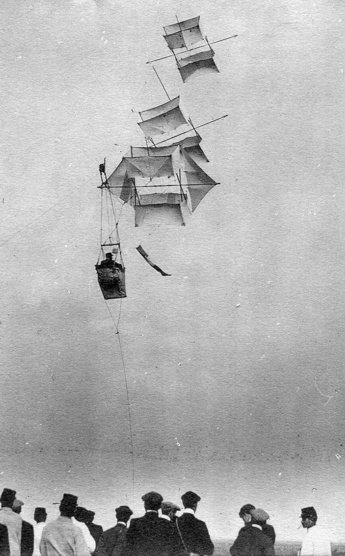
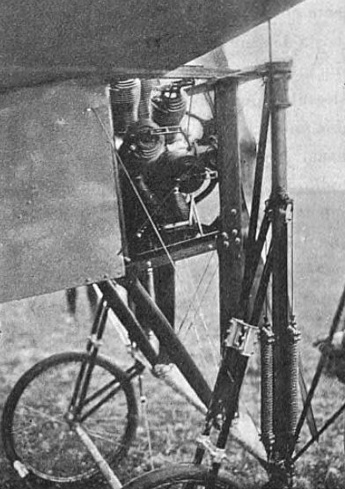
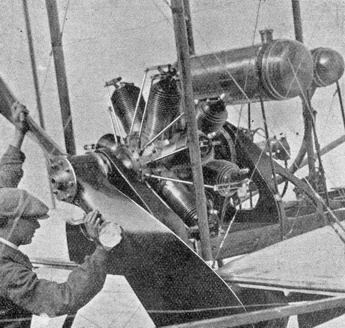
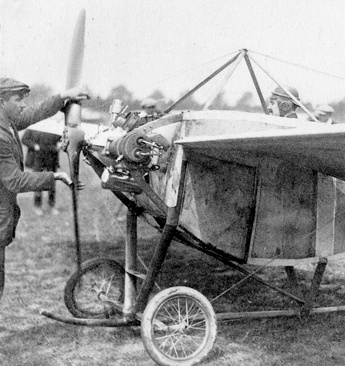
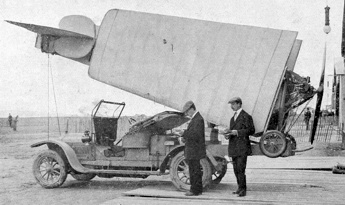
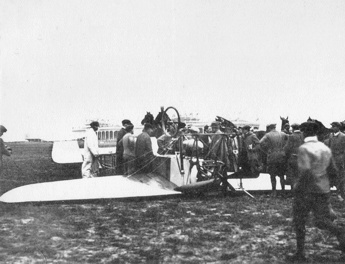

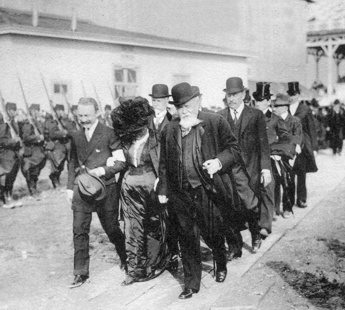
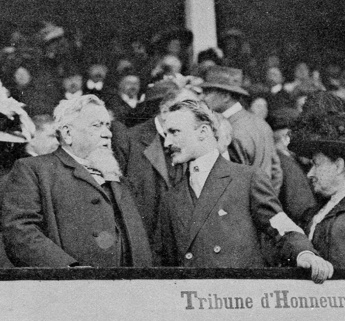
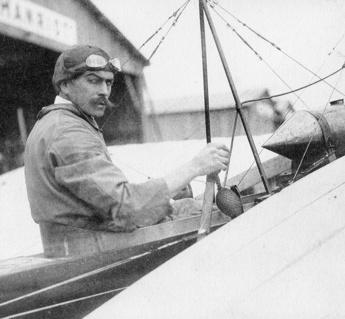
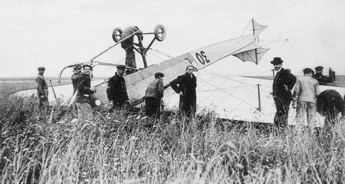
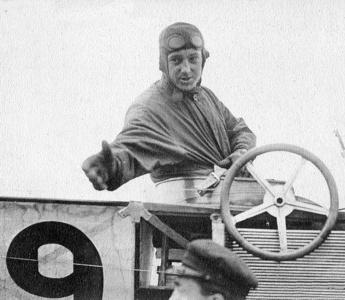
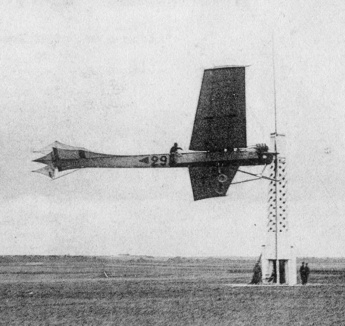
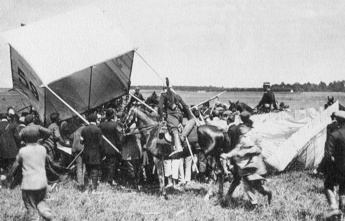
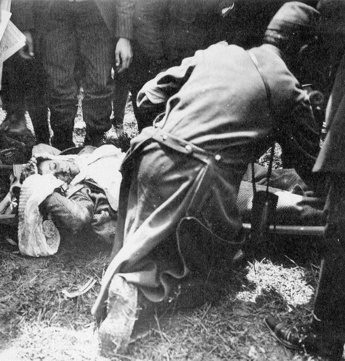
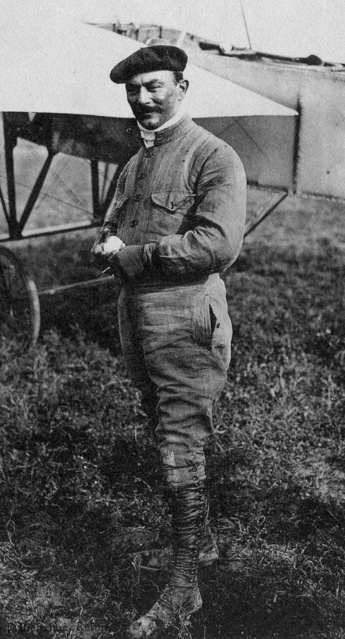
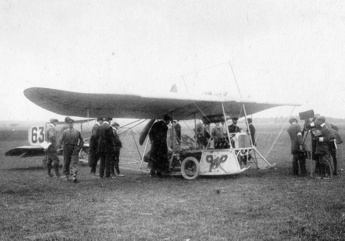
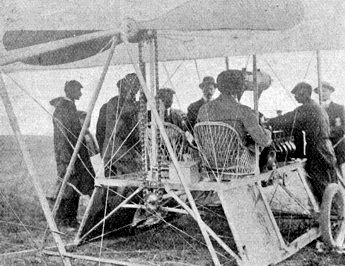
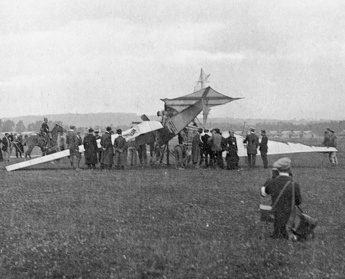
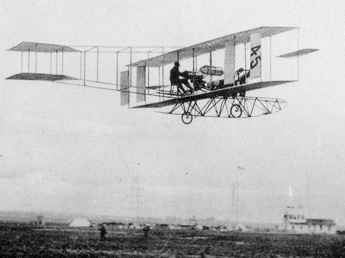
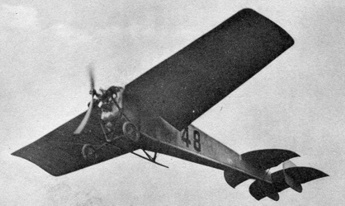
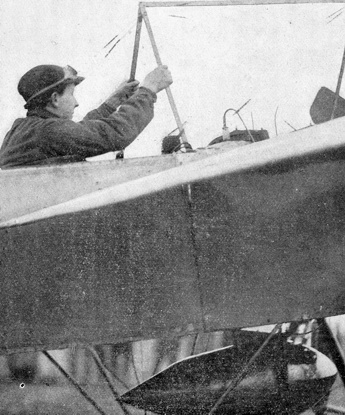


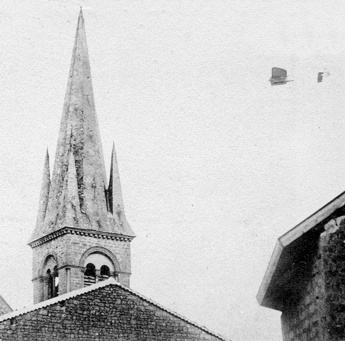

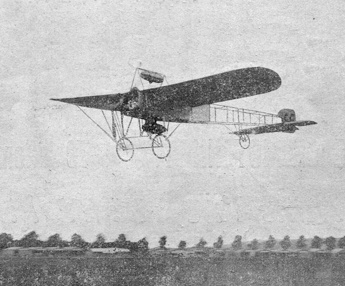
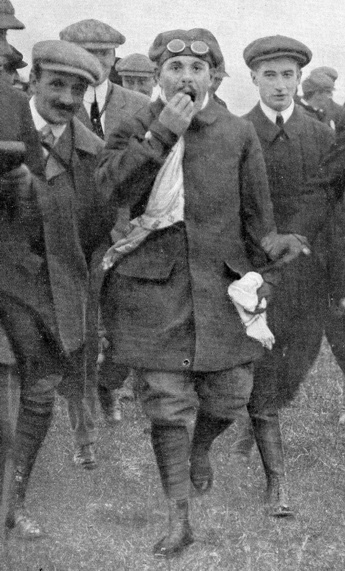
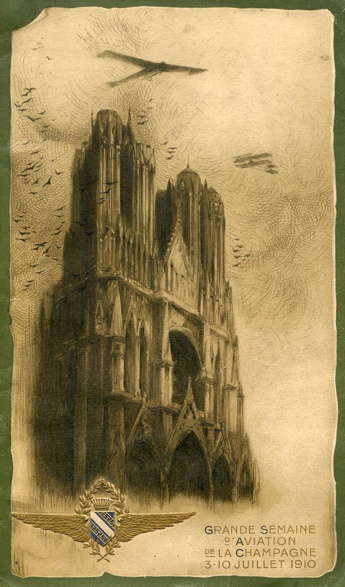
The 1909 "Grande Semaine d'Aviation de la
Champagne" was a huge success and a defining event
in the history of aviation. Plans for a follow-up event
started immediately after it ended and an organizing
committee created. The date for the meeting was decided
by a meeting of Federation Aeronautique Internationale on
January 10th, and wheels were set in motion to create an
aviation meeting that would surpass everything of its
kind.
Everything at the airfield had to be built from scratch
again, since the temporary installations used at the 1909
had been dismantled immediately after that meeting. The
main grandstands were built in approximately the same
position as the year before, only a little to the south,
but everything else was realigned. The hangar area was
enlarged and moved further to the northwest, closer to
the main road. The 1909 rectangular ten-kilometre course,
which had been criticized because too large parts of it
weren't visible to the public, was abandoned in
favour of a shorter five-kilometre course. This took less
than half the space and was more visible to the
spectators. The new course had six pylons, with two
90-degree turns and four 45-degree turns.
There were no participants from either Britain or the
United States, but despite this, 76 machines were
entered. They represented 14 different makes, but in the
end no machines from Wright, Tellier or Maurice Farman
would turn up. The most popular make was Henry Farman
with 14 entrants, followed by Blériot (12), Sommer (9),
Antoinette (8) and Voisin (8). Machines from Nieuport,
Sanchez-Besa and Pischof (called "Werner" in
the official program, after the manufacturers Werner &
Pfleiderer) would appear for the first time at a French
meeting.
Just like the year before, the Champagne manufacturers
made big contributions to the prize funds. A total of
more than 200,000 francs would be given to the winners.
There were a couple of novel contests. The biggest prize,
a single prize of 50,000 francs, was the "Grand Prix
de Champagne". It would be won the manufacturer
whose three best machines had flown the longest total
distance during the week. Another novelty was the
"Prix de Totalisation des Hauteurs", which
would be won by the pilot with the highest sum of
altitudes reached during any number of officially
controlled flights. The "Prix Michel Ephrussi",
named after its sponsor, a banker and breeder and racer
of thoroughbreds, was the first air race ever in which
the machines were released side by side at the same time,
in race-horse style. It was held over a cross-country
course of 22.4 kilometres. There was also a contest for
military kites.
Sunday 3 July
The first day of the meeting was windy. During the late
morning it started to rain, a fine persistent rain that
was interrupted from time to time by heavy showers. The
official flights started at eleven o'clock and at
11:11 Charles Wachter was first to take off in his
Antoinette. The wind was recorded as 12 m/s, and it made
him miss a couple of pylons on the first lap, but after
these initial struggles he went on to fly nine good laps
during a flight of 43 minutes. After Wachter's
landing, Farman pilot Charles Weymann took off, but he
landed after a single lap due to the torrential rain.
After noon René Labouchère took off in his Antoinette,
followed by Weymann. Labouchère went on to fly seven laps
in 32 minutes, while Weymann gave up fighting his
machine, which was pitching up and down, after three laps
and turned inside the course to land. He almost
immediately took off again, but again landed after only
half a lap.
At 14:13 Walther de Mumm in his Antoinette tried to take
off, but for some reason landed at the foot of the first
pylon and returned to his hangar. At three o'clock he
took off again and quickly climbed to 150 metres. He was
followed by fellow Antoinette pilot Hubert Latham, who
was driven far off the first pylon by the wind, but
returned to the course and landed after a well-controlled
16-minute three-lap flight. Weymann made his third start
at 15:15, also deflected by the wind at the first pylon.
He climbed to 20 metres before diving steeply to almost
ground level. During their flights Capitaine Madiot was
launched, standing in his balloon-type wicker basket
lifted by a train of four kites. The landing after his
short flight was heavy, but there were no damages.
Then a series of flights started, with Léon Morane first
to take off at 15:40, having trouble to take the pylons
accurately in the wind in his light Blériot. Robert
Martinet, in his heavier Farman, managed to make tighter
turns. The relatively unexperienced René Thomas, in the
fourth of the factory Antoinettes, lost control during
his take off and put the machine on its nose. At four
o'clock Wachter took off again, followed by Léon
Cheuret, Jules Fischer and Weymann, their three Farmans
framed by a rainbow. Jean Daillens took off on his Sommer
and then Charles Van den Born made it four Farmans in the
air, climbing to some 500 metres.
The winds had decreased a bit and several engines were
heard from the hangars. Étienne Bunau-Varilla and Henri
Brégi on Voisins, Marcel Hanriot on one of the monoplanes
of his father's make, Otto Lindpaintner on a Sommer,
Nicolas Kinet and Joseph Christiaens on Farmans, both of
the large-span model, and Jan Olieslagers on his Blériot
made for an interesting mixture of airframes and engines
in the air. There were now twelve or thirteen machines
circling around the five-kilometre course. Brégi's
flight ended with his machine upside down in an unmowed
field before he had recorded any official result, but
obviously without injuries. Maurice Tétard took off,
while Bunau-Varilla and Van den Born landed. Some
improvised races started to appear, particularly between
Wachter and the chasing Olieslagers.
The reporters had by now more or less given up reporting
the flights in any detail. They were probably as
overwhelmed as the timing staff, who after the first day
would give up recording exact flying distances and
instead only count whole laps. De Mumm, Louis Wagner and
Michel Efimoff took off, despite a huge, threatening
cloud that towered over the airfield. After a while the
weather improved, and more pilots took to the air,
circling "like flies around a lump of sugar"
according to the reporter from "Le Figaro". The
reporter from "L'Auto" claimed that it was
"as crowded at 30 metres as in the Rue de la Paix at
five o'clock in the afternoon", forcing Latham
to climb to the less busy altitude of 300 metres.
"Baroness" Raymonde de Laroche also took off,
leaving the airfield to fly above a train on the nearby
railway. Morane and Latham competed for the daily
altitude prize, which started at four o'clock and
which Morane eventually won by reaching 862 metres.
Around six o'clock there were only three or four
pilots still in the air. One of them was Wachter, who had
already flown 142 kilometres in his Antoinette, the
longest total distance of the day. He had started to
descend from an altitude of around 200 metres above the
fourth pylon, close to the Modelin farm, when his machine
suddenly pitched down and fell like a stone to the
ground, followed by its wings, which had folded upwards,
departed from the fuselage and slowly fluttered down in
zigzag. The onlookers screamed in horror, while the
ambulance services quickly rushed to the accident site,
but there was no hope. Wachter had been killed
immediately by the impact, suffering multiple fractures
and massive injuries to the head, back and chest. The sad
news had to be brought to his wife and his daughter of
five years, who had accompanied him to the meeting, and
to his brother-in-law Léon Levavasseur, the designer of
the Antoinettes. The structural failure of the machine
was blamed on Wachter over-speeding when descending to
land without cutting the engine, but the machine had made
five flights that day, in rain and hard winds, and it is
quite likely that the rigging had got loose.
Wachter, who was 36 years old, had worked as a mechanic
for Antoinettefor several years, particularly on racing
boat engines. He had only started flying two months
before the meeting, but had already made himself a name
as a daring and competent pilot and a popular instructor
at the Antoinette flying school. He became the
world's eighth pilot to die in a flying accident. The
accident put an end to the days' flying, except for
Efimoff, who made a last flight and was criticised for
"flying above the corpse of his comrade".
Until the accident the meeting had delivered an
unprecedented flying experience, despite the difficult
weather conditions. Altogether 24 pilots had flown during
the first day. Tétard's flight of 87.125 kilometres
had beaten Olieslagers to the prize for the day's
longest non-stop flight. Weymann was second in the daily
total distance contest after the unfortunate Wachter, his
139.750 kilometres beaten by less than three
kilometres.
Monday 4 July
The second day also started windy, but Émile Ladougne in
his Goupy biplane, Alphonse de Ridder in his Farman and
Bunau-Varilla made test flights between ten and eleven
o'clock. When official flights started at noon,
Lindpaintner was first in the air. He was followed by de
Mumm, Olieslagers, André Bouvier (Sommer) and Van den
Born, but because of the increasing wind all of them
landed soon. Olieslagers' flight of 20 kilometres in
17 minutes was the longest. Capitaine Madiot, however,
found the high winds more useful to test his kite
train.
When everybody had landed there was no action on the
airfield until three o'clock, when Weymann started
the engine of his Farman, but he decided that it was
still too windy and never left the ground. The other kite
train, of Lieutenant Basset, was also tested. Around half
past four the weather turned even worse, with a violent
wind from the north and dark threatening clouds. A window
pane in the press pavilion was broken by a gust, and
those who had hangars facing to the north started
worrying about their integrity.
The weather improved towards the end of the afternoon,
and at six o'clock Latham was first to take off, soon
followed by Sommer pilots Georges Legagneux and
Lindpaintner. When they had proved that flights were
possible several more flyers came out. Cheuret and
Nicolas Kinet took off in close succession in their
Farmans and flew closely above Olieslagers, but a
collision was avoided. Weymann, Ferdinand de Baeder and
Martinet also took off, all flying at minimum altitude
except Latham, who as usual wasn't afraid of heights.
De Baeder suddenly turned inside the course and returned
in front of the grandstands in the opposite direction,
predictably to be punished with a fine for his irregular
flying. Efimoff and Fischer took off, while Olieslagers
joined Latham at 150 metres, before the latter swooped
down and made a tight turn. Weymann suffered some bad
oscillations in the turbulent air. Wagner took off,
followed at 18:40 by André Frey on Émile Bruneau de
Laborie's big Savary biplane. Frey only got to the
end of the first straight before he had engine troubles
and made a heavy landing in an unmown alfalfa field. The
plane was wrecked, but the pilot escaped without injury.
Daillens was hit by a gust and broke the landing gear of
his machine when he touched down.
Labouchère, Bartolomeo Cattaneo (Blériot), and Hanriot
took off, making it fourteen machines in the air at the
same time. There was some light rain and like on the
first evening the spectacle was improved by a beautiful
rainbow. Christiaens, de Mumm, Morane, Émile Aubrun
(Blériot) and Thomas joined "la ronde
infernale", the "infernal circle", making
it eighteen machines in the air! Ladougne also took off,
and then chaos broke out as five machines came down
almost simultaneously at the far end of the airfield.
Ambulance services, reporters and officials, headed by
the responsible commissioner M. Houdaille, rushed away on
horseback, in automobiles or on foot. From the press
pavilion little could be seen even with the help of
binoculars, and rumours started to fly before the
officials could return with some facts. Thomas and
Weymann had made emergency landings without major dramas.
Cheuret had come down in an unmown oat field, breaking
the right wings of his Farman. Léon Bathiat had put his
Breguet vertically on its nose after an emergency landing
that ended in a pirouette-like ground loop, only metres
away from Cheuret. Martinet's engine had failed and
in the following crash he was thrown some ten metres from
his machine into the wheat. The sight of a pilot carried
on a stretcher on the opposite side of the airfield
raised grave concerns in the grandstands in view of the
fatal accident of the previous day. After a while it
emerged that the pilot was Martinet, and that his
injuries thankfully weren't life-threatening, only
two broken ribs. The other three pilots were
unharmed.
Then the cannon was fired, announcing that it was half
past seven and that the day's official flying was
over. Flights had only been possible during two hours,
but there had been an enormous lot of action and all in
all 29 pilots had flown. Morane, in his new 100 hp
14-cylinder Blériot, had won the daily speed contest by a
broad margin. He was the first to break a world record
during the meeting by covering the ten kilometres in
6:48.0, corresponding to 88.2 km/h. There would be many,
many more records broken in the following days… Latham
had made the day's longest flight. His 105 kilometres
beat Olieslagers' 85, and that single flight was also
good enough to win him the prize for the day's
longest aggregated distance. Olieslagers tied the 105
kilometres, but his flights had taken longer time.
After the official flights had ended a couple of
passenger flights were made, Aubrun with fellow Blériot
pilot Julien Mamet on board and Morane with Jorge Chávez
on board, the former perhaps giving new Blériot customer
Chávez instructions on how the machine worked. Bouvier
made a final test flight.
During the first two days of the meeting the unmown
fields outside the course had claimed five machines
during emergency landings. The 1909 meeting had been held
later in the year, when most of the surrounding fields
had been harvested, but now only a strip of around 100
metres had been cleared. The organizers hid behind the
rule that it was forbidden to land outside the course,
but, as pointed out by somebody, "rules are made on
the ground and not valid in the air". Another risk
that was pointed out was the kite trains that were
launched inside the course. They reached an altitude of a
couple of hundred metres and the consequences of an
airplane flying into their mooring wires would of course
have had been catastrophic.
Tuesday 5 July
During the morning the funeral services of Charles
Wachter were held in Reims, at the house of the Krug
family, friends of the unfortunate pilot. A large number
of officials, pilots, reporters and Antoinette employees
were present. His coffin was then taken to the railway
station for transport to Puteaux outside Paris, the
hometown of Léon Levavasseur, where he would be
buried.
Already at seven o'clock in the morning Jacques
Balsan made a successful test flight, showing good speed.
Édouard Nieuport also made a test in the morning in his
little monoplane, but otherwise there wasn't much
activity. When the official flights started at eleven
o'clock the weather was still good, with only light
winds. The main events of the day were the qualifications
for the speed contest and the qualifications for the
French team for the Gordon Bennett Trophy race, which was
to be held at Belmont Park in New York in October.
The qualifications for the speed event started
immediately. Three machines at a time were flagged off to
fly 20 kilometres, each with a delay of a minute, with
the best of each heat advancing to the next round. The
first starts went well and Wagner, Weymann, Nieuport and
Louis Blériot's partner and pilot Alfred Leblanc
completed their flights, while Ladougne and Alexander de
Petrovsky (Sommer) failed to complete the distance. After
only twenty minutes, just as Latham prepared to start,
the weather turned worse, with thunder and heavy rain,
followed by mist and a fine rain. At noon Jacques Faure,
with Marquis de Polignac as passenger, took off in a
balloon from Place du Boulingrin in central Reims, but
the wind refused to take it over the airfield and it
disappeared from sight in minutes.
At two o'clock the weather had improved again, but
nobody except the kite-flying officers ventured out onto
the waterlogged field until seven minutes past three,
when Mamet took off and climbed to 60 metres.
Lindpaintner followed him. At a quarter past three Latham
took off, and soon passed above Mamet, whose machine was
upset by the turbulence and had to land.
Due to the rain the time for the speed contest was
delayed by three hours, which meant that the two contests
were run at the same time, while other competitors were
circling the field adding laps to their tally for the
total flight time prizes. This made it very difficult to
keep track of what was going on, and the visitors in the
grandstands must have been completely confused. Even the
most diligent reporters, like Frantz Reichel of "Le
Figaro" and Pierre Souvestre and André Guymon from
"L'Auto" gave up trying to report in
detail. Realizing that one signal mast would be
insufficient, the organizers had installed two masts on
the airfield, but they couldn't by far report on all
the machines that were in the air at the same time. All
results were reported on the enormous result board behind
the grandstands, which had one column for each contestant
and one line for each event, but this could of course not
happen immediately. The proceedings were
"incomprehensible to the public and only barely
comprehensible for the initiated", according to
Souvestre, and the circulars containing the final results
of the day were not published until half past eleven in
the evening.
Leblanc completed the 100-kilometre distance for the
Gordon Bennett qualifications in 1 h 19:13.6, having to
run an extra lap in order to compensate for missing a
pylon in the hard wind. After the landing he seemed to
lose control of the plane, which like other airplanes of
that era did not have any brakes. It swerved towards the
fence in front of the grandstands. The dangerous
situation was saved by the pilot, who acrobatically
jumped out of the machine, which was rolling on the
ground, and managed to get hold of the left wing to stop
it. Behind him Latham took the second place, his time 1 h
24:58.6. Later, at six o'clock, Ladougne made his
effort, showing good speed in the fastest of the biplanes
but failing to complete the 100 kilometres. Labouchère
was in the air at the same time, taking the third place
with 1 h 25:24.0, the three monoplanes being the only
ones to complete the distance. According to some reports
Legagneux, de Baeder, Wagner and Mamet also tried, but
failed to complete the distance.
Morane and Leblanc were in a class of their own in the
speed contest, their best times over the 20 kilometres
(13:08 and 13:14, respectively) being more than a minute
and a half better than those of Antoinette pilots Latham
and Labouchère, who posted the third and fourth best
times of the twelve who qualified for the second round.
We have not managed to find a report on exactly how the
heats were composed and how the qualifications worked,
but it appears that at least fifteen pilots took part.
Apart from those mentioned above, it is known that
Olieslagers, de Baeder, Aubrun and Kinet also took
part.
Perhaps because so many pilots had participated in the
day's previous events, or perhaps because the field
was still so wet, there was not so much activity during
the last hour. De Mumm crashed his Antoinette at some
point during the evening. Labouchère, Latham, Wagner,
Olieslagers, Cattaneo and Weymann were all circulating
when the daily altitude contest started at five minutes
before seven. Morane, Olieslagers and Aubrun climbed
high, followed by the slower Latham. Morane won by
reaching 550 metres, beating Latham's 390.
While Morane glided down in a dramatically steep
"vol plané" Latham left the airfield and flew
two circles around the cathedral of Reims at an estimated
altitude of 800 metres before returning to make a perfect
landing. The daily non-stop distance contest was won by
Labouchère, whose 110 kilometres beat the 105 kilometres
of Latham and Olieslagers. The daily total distance
contest was won by Weymann, who covered 135 kilometres,
in front of Latham and Labouchère. During the day's
contests all speed records for all distances up to 100
kilometres were beaten, those from 5 to 20 km by Morane,
those for 30 and 40 km by Olieslagers and the remaining
distances by Leblanc. According to Frantz Reichel of
"Le Figaro" at least 28 pilots had flown during
the day.
Wednesday 6 July
During the first three days of the meeting the weather
had at least been good at times. Not so on the fourth day
- the weather was miserable from early in the morning
until late in the evening. It rained constantly, and the
wind was as strong as on any of the previous days. The
airfield turned into a sea of mud where it was difficult
to drive cars and even horse carts got stuck, so it was
perhaps just as well that nobody wanted to fly. Workers
tried to improve conditions by spreading sand and clinker
on the roads and laying planks in front of the
grandstands.
At a quarter past nine there was suddenly a large cloud
of smoke from the hangar of René Thomas. A mechanic had
been doing some soldering too close to an open fuel
canister. The fuel had caught fire and the flames
threatened the 1,200 metres of wooden buildings that
surrounded the airfield. Thankfully there were lots of
people in the neighbouring hangars and 22 fire
extinguishers were soon emptied over the fire, quickly
putting the flames out. The fire in itself caused little
damage, but one of Thomas' mechanics was lightly
burned and a carpenter who was working in a hangar was
run down and trampled by the horse of one of the soldiers
who galloped to the hangars to help. He was brought to
the airfield hospital to be treated for a fractured
pelvis. Nothing else happened. At eleven o'clock a
team of mechanics brought back the remains of de
Mumm's crashed machine. The officers brought out
their kites, but it was too windy for them too and Basset
suffered from seasickness in his bobbing and weaving
basket. The cannon signalled the start of the day's
official flights at 11:30, but nobody cared. The rain
stopped towards the end of the afternoon and there was
even some sun, but the gale continued to blow and the
rain soon returned.
This was the day when Armand Fallières, the president of
France, visited the airfield, and just like the year
before he brought bad weather. He arrived at the airfield
at five o'clock, having taken the train from Paris
two hours earlier. He was accompanied by his wife and son
and a large entourage of ministers, officers and
government personnel. He was greeted by the organization
committee and by the 137th infantry regiment and its
band, before being brought to a meeting with Hermes da
Fonseca, who had been elected president of Brazil and was
on a tour of Europe before officially taking his
position. This was followed by a tour of the hangars. The
president was going to return to his train at half past
seven, and at 19:25, when all speeches had been held and
the preparations for his departure had already started,
it looked like he would have to return to the capital
without seeing any flying. The wind speed reached 13-15
m/s in the gusts.
But, just as the year before, a couple of brave pilots
saved the day. The first machine to be hauled out onto
the mud was Latham's Antoinette, and in the
president's pavilion people got out of their chairs
to watch the action. The president and his wife were a
bit alarmed, since they didn't want anybody to risk
their life for their sake. Latham's machine was
followed by two biplanes, the Farmans of de Baeder and
Weymann. De Baeder was first in the air but landed
already after 250 metres. Weymann was next, his machine
pitching and rolling dramatically in the turbulence
during a one-lap flight. Latham was last to take off and
as usual handled the wind with confident ease during two
laps. All three landed safely in front of the
grandstands, Latham last. Madame Fallières cried
"I'm so pleased, there was no accident!"
and everybody cheered, sighed of relief and got on with
the ceremonies around the departure. The president and
and his entourage were driven to the station and were
back in Paris at ten o'clock in the evening.
Thursday 7 July
The weather was a little bit warmer, but it was still
gusty and rained from time to time. The official flights
started with the main event of the day, the second round
of the heats for the speed contest. The object was to
qualify nine machines for the semi-finals and finals,
which were to be held on the last day of the meeting. The
twelve pilots who had qualified after the first round ran
two by two in six four-lap heats, with the intention to
eliminate the three slowest. In the first heat, Efimoff
failed to take the start on time, while Morane was
disqualified, despite flying an extra lap, after missing
the third pylon on three of his laps. The second heat was
the only one where both planes completed the distance,
with Latham beating Lindpaintner. In the third heat
Leblanc scored the best time, 14:12.2, while Aubrun had
an incident during the take-off and damaged his
propeller. The fourth heat was won by Labouchère, while
de Baeder landed after the first lap. The fifth heat saw
Olieslagers win, while Wagner landed after one lap. The
sixth heat was again a complete failure, when Weymann
failed to start on time and Nieuport landed already after
one lap. After these heats only five pilots had
qualified, so in order to complete the field it was
decided to run three second chance "repêchage"
heats later in the afternoon.
At one o'clock the wind was around 7-9 m/s, so while
conditions were reasonable it was still a bit windy. The
course was left open for the "carousel", the
free session for the pilots who circled the course
competing for the distance prizes. The "desperate
monotony" of this was by now regarded as an ordeal
by some of the reporters, but they could still look
forward to the struggle between particularly Latham,
Olieslagers and Labouchère for new world distance and
endurance records.
The slightly faster Olieslagers was separated from
Latham, who started a little later, by only one minute
and twenty seconds after 150 kilometres. Olieslagers went
on to set a new world record for 200 kilometres, which he
covered in 2 h 47:04.6, and after three hours he had
covered 212.750 kilometres. The 200-km record was soon
erased by Latham, whose time was 2 h 46:02.0. Latham
landed after 215 kilometres, but Olieslagers kept on
flying and at 16:23 the time-keepers signalled that he
had beaten the world distance record, previously held by
Henry Farman at 234.212 km. This coincided with the start
of a rain shower, and Olieslagers landed after 235
kilometres, which he had covered in 3 h 02:04.8.
Labouchère also intended to go for the long-distance
record but had to land after 190 kilometres when he ran
out of fuel. He made a cross-wind landing and
ground-looped his machine, which turned over on its back
at low speed with amazingly small damages.
While this went on, Weymann crashed in a wheat field
after a flight of 25 kilometres. He was unharmed, and he
was back in the air later during the afternoon, flying
another Farman machine. Lindpaintner was driven towards
the fence in front of the grandstands and had to crash
deliberately to avoid hitting them. De Petrovsky was also
in trouble, being forced to the ground by the turbulence
and breaking a wing. He blamed Kinet, who he claimed to
have passed him only 15 metres away, and said that he
intended to file a formal protest. Wagner and Hanriot
impressed with their speed, while several other pilots
tried their wings, among them Bathiat, Ladougne,
Legagneux, Cattaneo, Efimoff, Fischer, Van den Born,
Mamet, Thomas, de Baeder, André Frey, Alfred de Pischof
and Kinet.
Two of the four announced Army pilots had finally
arrived, their flight from Mourmelon having been
postponed because of the bad weather, and Lieutenant
Albert Féquant in his Farman scored 15 kilometres for the
contest for the officers' prize. Lieutenant Félix
Camerman, whose machine was still at Mourmelon, flew the
machine of Christiaens, and therefore his result
didn't count.
The second-chance heats for the speed contest were run at
five o'clock. Morane was the only starter in the
first heat, his time of 13:46.0 beating the best times of
all the other qualifiers. Wagner won the second heat and
the slower de Baeder dropped out after two laps. It
appears that the third heat, which should have matched
Aubrun against Nieuport, was not run. There were thus
only seven pilots qualified for the semi-finals.
The daily altitude contest ran until seven o'clock.
During the take-off run one of Olieslagers' wheels
got stuck in a rut and the aircraft nosed over and turned
over on its back. The accident was not as bad as it
looked, the Belgian was unharmed and the only damage to
the machine was a broken wheel and a broken propeller.
Latham took off, followed by Balsan and de Baeder, but
the match for the prize was between Latham and Morane,
who disappeared quickly into the sky in his faster
Blériot. Latham disappeared into a cloud and reappeared.
Morane gave up after ten minutes, later stating that he
didn't like flying into the clouds and was frightened
when he didn't see anything. He returned to land in a
steep glide. De Baeder also descended, announcing his
approach by means of a siren and landing smartly
immediately in front of his hangar. Latham kept flying
for another five minutes, flying into and out of the
clouds. Exactly when the cannon announced the end of the
days flying he appeared from a cloud to the right of the
grandstands and started a masterful glide of four or five
minutes, including two circles around the timing tower.
He had reached 1,384 metres, beating Morane's 1,110.
Reports claimed it was a world record, and it still
stands as such in some lists, but it did not beat the
1,403 metres reached by Walter Brookins in a Wright at
Indianapolis on June 17th. Nevertheless, Latham was
hailed as a "surhomme", a superman, and carried
in triumph from the hangars. Around 30 pilots flew during
the fourth day. Olieslagers' total of 255 kilometres
won him the daily total distance prize, in front of
Latham's 230.
Friday 8 July
On the sixth day of the meeting the weather was finally
good, with higher temperatures and almost calm air. The
day saw an unprecedented amount of flying, but this was
overshadowed by the horrific accident of
"Baronesse" de Laroche.
There were already around ten machines in the air, among
them Latham, Lindpaintner, Bunau-Varilla and Weymann,
when she took off at around ten to one. She completed a
lap and then climbed to 50 metres before starting the
second. At the end of the second lap she took a wide turn
at the fifth pylon to avoid some faster competitors. Her
machine then suddenly pitched up, then down, and dived
into the ground, completely breaking into pieces.
Ambulances and reporters rushed to the crash site, which
was some 1,500 metres from the grandstands. They found de
Laroche almost buried in the debris, barely conscious and
obviously very badly injured. She was carefully
stretchered to an ambulance and transported to the
airfield hospital. The initial reports were pessimistic,
and some early reports even stated that she was dying. At
half past three the airfield doctors published a
bulletin, stating that she had suffered a complicated
fracture of the right lower leg and fractures of the left
arm, the left thigh and the left index finger. In
addition to that she had dislocated the right hip and got
several minor cuts and bruises. Her injuries would
certainly have been worse if she hadn't tried to rise
off the seat to avoid hitting the control wheel in the
crash. The doctors' forecast stated that there was
hope for her recovery. She was transported to the surgery
of doctor Roussel in Reims, where her fractures were set
during the late evening, without sedation and with only
chloroform for pain relief. The bulletins issued
afterwards by the doctor were carefully optimistic.
Initial rumours said that the accident was caused by
Lindpaintner passing her too closely and forcing her to
fly into his propeller wash. He was rudely abused and had
to be protected when he returned to the pits. The
officials, represented by sports commissioner Édouard
Surcouf, quickly issued a statement that this was not the
case, and that Lindpaintner had been too far away to have
affected her. There were also witnesses who claimed to
have heard the engine stop before the crash. The Voisin,
like other early pushers, had lifting tail surfaces that
were blown by the propeller slipstream. The effect of the
engine suddenly stopping would have been that the tail
lost lift and the machine pitched up, quickly losing its
forward speed.
The controversies were not silenced the by the official
statement, though, and on the next day three witnesses,
including pilots Chávez and Morane, requested that the
incident would be reinvestigated. They claimed that their
observations had been misrepresented and that
Lindpaintner had indeed cut the corner closely in front
of de Laroche. The "procureur de la republic"
(public prosecutor) of Reims announced that he would open
an enquiry into the conditions around the accident,
according to "Le Figaro" for the first time in
the history of sports.
While everybody was following the rescue and the reports
about the status of the baroness, another accident
happened. This was de Petrovsky, who was now flying the
Sommer of Efimoff, since his own machine was damaged the
day before. He crashed rather heavily and the machine was
badly smashed up, but the pilot escaped with a fractured
wrist.
With these dramatic incidents on everybody's minds it
is natural that the reporting of the day's other
activities suffered, but in many ways it was a repetition
of the day before. Olieslagers and Latham again crossed
horns trying to break the distance records. Latham
started a little earlier and flew the first 100
kilometres in 1 h 20:30.0, not quite matching
Olieslagers' record of the day before. Olieslagers
was not as fast as Latham during the first hour, his time
half a minute slower at 1 h 20:51.6, but then he must
have turned up the wick, because he reached 150
kilometres in 1 h 58:20.4, beating that record of the day
before. Starting first, Latham was first to reach two
hours and posted a new record of 147.750 kilometres. His
joy was short-lived, though, since Olieslagers reached
152.125 kilometres in the same time. Latham landed after
160 kilometres, which he reached in 2 h 09:33.6, while
Olieslagers continued to reach 225 kilometres in 2 h
55:05.4, in the process also beating setting a new
200-kilometre record of 2 h 35:18.2. After the flight he
said that he was disappointed not to have gone further,
but he had run out of fuel. Both Latham and Olieslagers
went up again, the latter lowering the 100-kilometer
record to 1 h 16:42.2 and that of 150 kilometres to 1 h
54:54.4 before landing after another 195 kilometres and 2
h 29:34.4 in the air, having covered a total of 420
kilometres in one day - the distance between Paris and
London! Latham landed already after 40 kilometres.
Meanwhile, the short-distance speed records also fell.
The 10-kilometre record was beaten first by Morane's
6:35.0, and then by Leblanc's 6:33.6. Leblanc also
set a new 5-kilometre record during the same flight,
covering a lap in 3:12.8.
In the shadow of the record-beaters several pilots flew
impressive distances. Cattaneo made a non-stop flight of
170 kilometres, beating Latham to second place in the
daily contest, while Labouchère was fourth at 125 and
Kinet fifth at 110. Legagneux flew a total of 300
kilometres during the day, winning the second prize in
front of Weymann's 270 and Cattaneo's 260. The
Voisin pilots didn't have much to cheer for, but
Bunau-Varilla flew 100 kilometres in 1 h 23 minutes,
which was claimed to be a world record for biplanes.
Altogether 32 pilots flew during the day, 13 of them
covering more than 100 kilometres. The busy time-keepers
had registered no less than 760 laps flown!
After the end of the official flights several of the
pilots, among them Leblanc, Aubrun, Morane, Legagneux and
Bathiat took prominent guests for passenger flights.
Bathiat's passenger probably got more excitement than
he had asked for when the machine crashed, but neither
the pilot nor the passenger was injured.
Saturday 9 July
The weather was calm, with winds of only 3 m/s, but low
clouds covered the airfield. This was the last day of the
constructors' prize, so it could be expected that
many would go for long-distance flights. At the beginning
of the day, Antoinette stood at a total distance of 1,701
kilometres flown by their three best machines, Blériot at
1.463, Farman at 1.427 and Sommer at 1,269. It had been
decided during the morning to deduct the 270 kilometres
that Weymann had flown the day before from Farman's
total. According to the rules it was the machines that
counted, not the pilots, and several competitors had
protested that the machine Weymann used on the Friday was
not a rebuild of the machine that was damaged when he
crashed on the Thursday, but a completely different
machine.
When official flights started at eleven o'clock,
Thomas was first to take off, accompanied during the
following half hour by Daillens, Legagneux, Latham,
Wagner, Fischer, Kinet, Lindpaintner, Labouchère,
Olieslagers, Weymann and Cattaneo. At half past eleven
Mamet took off with two passengers on board, his brother
and his mechanic M. Lemartin. He landed after a flight of
97.750 kilometres, having beaten all two-passenger
records for both speed and distance. Latham landed after
125 kilometres, Fischer after 100 and Weymann after 95.
Lindpaintner, Olieslagers and Legagneux landed after 65
kilometres. Thomas made two flights of 90 kilometres each
but his second landing, around a quarter to four in the
afternoon, was very heavy. It broke the upper rigging of
his machine and made the wing tips drop to the ground.
André Noël also crashed his Blériot when the machine was
hit by turbulence, but apparently without any
injuries.
Labouchère landed after 40 kilometres and after a short
pause took off again at 12:43. Aubrun took off with one
passenger on board and made a flight of 85 kilometres,
also beating several passenger speed records. Olieslagers
was busy too, beating the records for 50 kilometres and
for one hour. Morane took out the 100 horsepower Blériot,
making "a terrifying impression, like an arrow that
splits the air". His time for five kilometres was
2:51.0, corresponding to 105 km/h, a new world record.
Lieutenant Camerman finally flew in from Camp de Châlons,
some thirty kilometres away, on a Farman with the French
"tricolore" flying from a wing strut. This
meant there could finally be a contest between the two
military pilots on the last day of the meeting. When he
was congratulated for his 24-minute cross-country flight,
made at altitudes up to 400 metres, he didn't accept
any praise and modestly replied "J'étais en
service commandé".
While this went on, Labouchère just kept flying and
flying. At 16:26 the signal mast indicated that he had
beaten Olieslagers distance record from two days before,
but he didn't stop. After 4 hours and 14 minutes he
reached 300 kilometres. After 4 hours and 39 minutes he
finally landed, having flown 340 kilometres. When
interviewed in the evening he stated that he had believed
that the extra-large fuel tank would have kept him in the
air for five hours, so he brought bread, chocolate,
cookies and fruit to eat. He had eaten for the first time
after one hour. He said it was impossible to count the
laps, so he had watched the signal mast to keep track of
his progress. He was worried that it didn't show
anything at all in the beginning, not until he had
completed the first 100 kilometres. When he finally saw
the white ball that signified a world record hoisted
beside his signal, a red ball and a red
"diabolo" double cone, he knew that he had
succeeded and celebrated with a second meal of bread and
chocolate. He didn't want to risk running out fuel,
so he decided to land after four and a half hours.
Aubrun made a second passenger flight, reaching 137.135
kilometres in 2 h 09:07.8 with Émile Reymond, a senator
from Loire, on board, beating his previous mark. This new
world record flight did not count for the passenger
prize, however, since he had started after the end of the
time allowed for the contest. As all the reporting of the
day's flying centred on the record-beating, there
were unfortunately few reports of the rest of the
day's flying in the press. As usual, the daily
altitude contest was held at the end of the day. It was
won by Morane, who disappeared in the low clouds and
reached 741 metres before making another spectacular dive
for the airfield, with de Baeder placing second.
The standings in the "Grand Prix de Champagne"
didn't change during the day. The Antoinette team of
Labouchère, Latham and Thomas won the 50,000 francs by
reaching 2,601 kilometres, beating the best Blériots of
Olieslagers, Cattaneo and Aubrun by almost 300. The
usually troublesome Antoinette engines ran without any
problems, according to some reports because they were
improved versions with carburettors instead of the fuel
injectors that in the past had proved so sensitive to
contaminated fuel. This reliability was in complete
contrast to the ENV engines. These usually dependable
V-8s failed left and right, forcing Voisins, Savarys and
de Mumm's reengined Antoinette to make emergency
landings time after time. The engine of
Bunau-Varilla's Voisin was replaced four times during
the meeting!
The Sommer pilots made several passenger flights and when
the cannon announced the end of the day's flying,
Legagneux was flying above the cathedral of Reims with
Paul Painlevé, the politician, mathematician and creator
of the world's first university course on
aeronautics, on board. Without any previous practice on
the type Chávez made his first flight in a Blériot,
having decided to buy one in place of his Farman. Before
starting, he said "if it stumbles, I will stop, if
it goes well I'll fly right away". He pulled the
stick after a roll of 20 metres, immediately climbed to
200 metres and made a flight of 30 minutes.
Sunday 10 July
The main events of the last day of the meeting was the
semi-finals and finals of the speed contest and the
cross-country race for the "Prix Michel
Éphrussi". The weather was fine, and the wind was
less than 3 m/s. Since six o'clock in the morning
there had been a steady flow of people on foot, on
bicycles and on kinds of cars and carriages heading
towards the airfield. Trains arrived every five minutes
to the temporary station at Fresnois. The grandstands and
public areas were full of people and it was estimated
that more than 100,000 people watched the day's
flying.
The first semi-final of the speed contest staged Morane
against Lindpaintner. The Frenchman won, as expected. His
time was 12:49.6, beating Lindpaintner by the huge margin
of seven minutes over the twenty kilometres. In the
second semi-final, Leblanc won by walkover, since
Labouchère couldn't make the start, but he still
finished the distance in 12:58.8. Three pilots contested
the third and slowest, but most exciting heat, in which
Olieslagers overtook both Latham and Wagner and won the
last of the three places in the finals.
The finals were run at 12:20. Morane was first to get the
starting signal, with Leblanc and Olieslagers following
at one-minute intervals. They finished in the same order,
with Morane scoring the best time over the distance
during the meeting, 12:45.6, yet another new world
record, beating Leblanc by ten seconds and Olieslagers by
thirty.
Many pilots tried to improve their results in the total
distance contest. Fischer flew 175 kilometres in a flight
of 2 h 26:24 and Labouchère flew 100 kilometres. Kinet,
Cattaneo, Bouvier, Weymann, Thomas and Legagneux also
added considerably to their totals. There were a couple
of incidents, too: Latham's Antoinette pitched down
and hit the ground in front of the grandstands. Paul
Hesne made a heavy landing in his Breguet, but without
causing any damage, while Bathiat in the other Breguet
had a third accident when his machine nosed over close to
the timing tower, also this time with only minor damages
to the wings of the sturdily built machine. Lieutenants
Camerman and Féquant contested the officers' prize,
the former flying the 50 kilometres in 46:50, beating his
colleague by 50 seconds.
At three o'clock Olieslagers took off again, with the
intention to take the world distance record back from
Labouchère. His Blériot was now equipped with extra fuel
tanks both above and below the fuselage. At 5:10 it was
announced that he had broken the speed record for two
hours, at 5:15 the record for 200 kilometres and then
followed records for all whole and half hours and for
every even 50 kilometres flown.
At six o'clock, when Olieslagers had been in the air
for three hours, a cannon shot called the ten competitors
to line up for the Prix Michel Éphrussi, the first air
race ever where planes started side by side, in racehorse
style. Eight were monoplanes, flown by Wagner, Hanriot,
Latham, Morane, Leblanc, Aubrun, Nieuport and de Pischof.
Aubrun was also carrying a passenger, a Madame
Charbonnel. The remaining two were Farman biplanes, flown
by Lindpaintner and Weymann. The course would first take
the flyers eastwards from the airfield to the church
tower of Witry-lès-Reims, which could be seen from the
airfield. The second leg took the flyers out of sight,
northeast towards the next turning point, a factory
chimney in Bazancourt. The third and last leg was a long
straight past the village of Fresne-lès-Reims and back to
the airfield, making a total distance 22.4
kilometres.
The machines were released three by three, by shots from
the starter's pistol. Wagner was first off the ground
in the #66 Hanriot originally entered for Fernand
Delétang, followed by Marcel Hanriot and Lindpaintner.
The second trio consisted of Aubrun, Latham and Morane,
but the latter failed to make the start because of a
blocked fuel line. De Pischof, Nieuport and Leblanc took
off in the third trio, Leblanc making it look like the
others were standing still. Weymann was alone in the
fourth set, in an un-numbered spare Farman, but he
retired to his hangar after only two minutes. Aubrun
failed to take the first turn correctly and had to return
to pass the church tower a second time. Wagner was also
first to return to the airfield, easily recognizable by
his bright red jersey. He only placed second, though,
because Leblanc was close behind and his time of 20:14.0
had Wagner beaten by 43 seconds. Lindpaintner glided into
the airfield from high, probably knowing that he had no
chance against the faster monoplanes, and then Hanriot,
de Pischof and Nieuport arrived almost simultaneously. In
the results Nieuport was a distant third, more than two
minutes slower than Leblanc, but it was still a great
performance by his little monoplane, which only had a 20
horsepower two-cylinder Darracq engine. Latham had to
make an emergency landing in a field three kilometres
from the airfield.
Meanwhile, Olieslagers was still in the air. He had
passed 320 kilometres when the time allowed for the total
distance prize ran out, so the remaining distance would
not count for the official results of the meeting. He
flew on for four and then five hours, beating records all
the way, and finally landed after 5 h 03:05.2, having
flown 392.75 kilometres, a fantastic new world record.
This also meant that he took the lead in the Coupe
Michelin, which was offered for the longest non-stop
flight during the entire year of 1910. One report stated
that Olieslagers followed a strict diet during long
distance flights, only drinking lemon juice and eating
dried meat while flying, while another report claimed
that he brought sandwiches and Flemish beer aboard!
In the altitude contest Chávez climbed to 1,150 metres
after a somewhat uncertain start in only his second
flight in the unfamiliar Blériot. He gave up after
reaching the clouds, in which he didn't feel he could
tell which way the machine was pointing. He beat
Morane's second place result from the Thursday but
failed to reach Latham's 1,384 metres, also set on
the Thursday. De Baeder, Cattaneo, Lindpaintner, Wagner
and Tétard also tried, all beating their previous best
efforts. At seven o'clock, when the meeting closed,
lieutenants Féquant and Camerman took off to fly back to
Camp de Châlons. They were followed by Maurice Colliex,
who flew his Voisin to the company base at Mourmelon, on
the same field as Camp de Châlons. The last flight of the
day was made by Mamet, who took off at half past seven
with journalist M. Poillot on board. They quickly climbed
to 500 metres and flew to Reims. On the way back, they
lost their way in the increasing darkness and landed at
Witry-lès-Reims, some five kilometres east of the
airfield, before they found their way back.
Conclusion
Due to the bad weather the meeting didn't attract as
many spectators as the previous one, but otherwise it was
from all sporting, financial and organizational aspects a
complete success. Nevertheless, an event of that size
wouldn't be organized again until after the Great
War. The Reims meeting had outgrown itself, and the huge
effort and expenses of a follow-up meeting could not not
be justified.
It had been realized already during the biggest meetings
earlier in 1910 that the novelty of simply seeing
airplanes fly soon wore off, and that the uninformed
crowd in the end found the endless circling of airplanes
at safe speeds and low altitudes rather monotonous. The
lack of public announcement systems and other practical
means of informing about what was going on surely played
a part, since only the most initiated could tell whether
the plane just passing by was on a world record flight or
simply cruising. The simple fact was that too much went
on at the airfield at the same time and even the
initiated reporters found it difficult to keep track. The
safety issues of the dense traffic around the course were
also a concern, and several accidents were caused by
airplanes being upset by the turbulence created by
others. A new format of air racing would be tested a
month later, the multi-stage cross-country "Circuit
de l'Est"!
A month after the meeting it was reported that 21 flyers
who had damaged their machines during the meeting were
going to sue the organizers for damages. They claimed
that their machines had been unnecessarily damaged by
landing in the high crops outside the narrow mowed strip
along the course, which did not conform with the
regulations of the Aéro-Club. Martinet, who had been
hospitalized for three weeks, claimed an additional
20,000 francs. It would be interesting to know how this
process ended...
The bulletins regarding the status of de Laroche became
more and more optimistic for every day. She faced a long
rehabilitation, but eventually recovered completely. She
was back at the controls of an airplane in 1912, and
after being grounded during World War One she lost her
life in an accident while testing a Caudron biplane in
1919.
 Back to the top of
the page
Back to the top of
the page